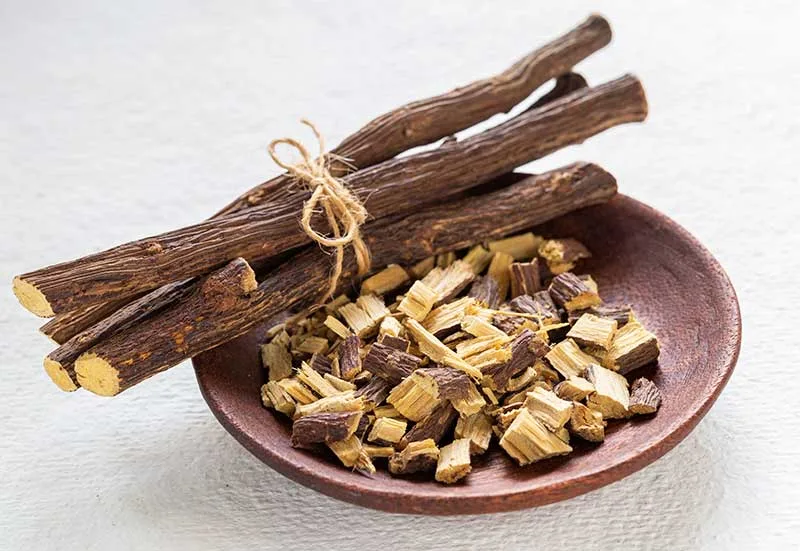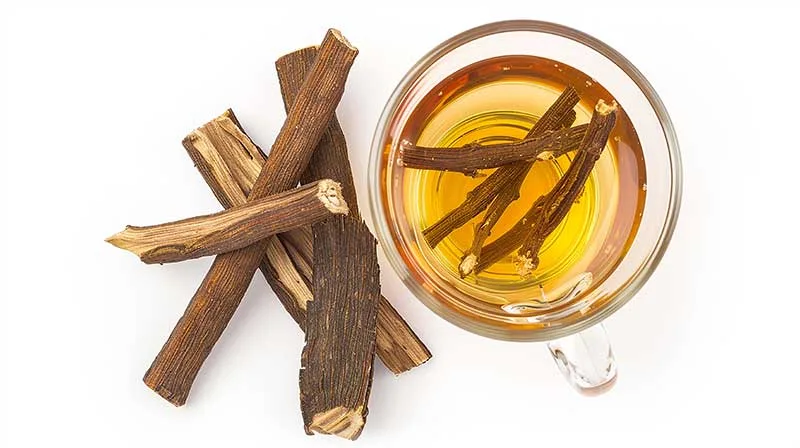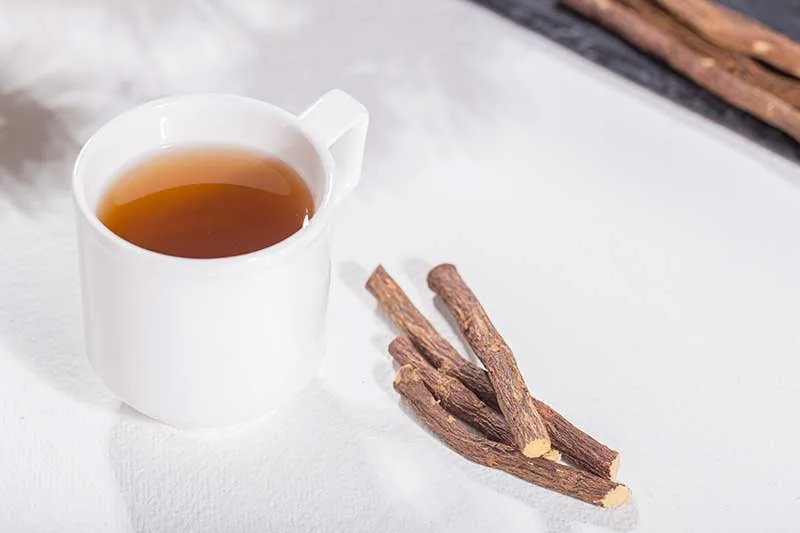Licorice Tea 101: Origin, Health Benefits, and Best Recipes
You’ve probably heard of licorice as a flavoring in gum, candy, or herbal medicine, but few people know how delicious, fragrant, and potent its herbal tea is. Licorice plant has a brown root with a distinctive, sweet flavor when chewed or brewed into a cup of herbal tea. It has been a staple of traditional Eastern and Western medicine for centuries. Interestingly, the sweet taste of this plant does not come from sugar at all, but from a substance called glycyrrhizin, which is several times sweeter than sugar.
Many people either fall in love with licorice tea or quickly reach for an additive to make the taste a little milder when they try licorice tea for the first time. In addition, this drink has amazing properties for the throat, stomach, and calming the nerves.
Licorice and its herbal tea is a world to explore, so hop on and join me on the journey to learning everything about licorice, its history, health benefits, brewing recipes, and tips to make this tea more delicious.
Origin of Licorice
Licorice is a perennial plant that is mostly grown in the Mediterranean region, Western Asia, and parts of Europe. Its use throughout history goes back thousands of years, when the Egyptians used its extract to make medicinal drinks. Its traces have been found in the tomb of Tutankhamun.

Licorice was, and is, one of the main herbs for brewing decoctions in several counties with rich tea history and culture. In traditional Chinese and Iranian medicine, licorice had a special place and was used as a companion plant to balance the properties of other plants.
The Role of Licorice in Traditional Medicine
In traditional Iranian medicine, licorice tea is prescribed to strengthen the stomach, relieve coughs, soften the throat, and reduce inflammation.

In traditional Chinese medicine, it is called the harmonizing herb because it is believed to enhance and balance the effects of other herbal medicines. Even in Ayurvedic medicine, this herb has been used to cleanse the body and calm the nervous system.
What Are The Health Benefits of Licorice Tea?
Both licorice root and its herbal tea are a precious chest of health benefits, so much so that many books written about herbal teas have dedicated an entire chapter to just talking about their health benefits.
Let’s explore 7 of the most important and well-researched health benefits of licorice tea.
#1 Anti-Inflammatory Properties
Glycyrrhizin in licorice has anti-inflammatory and antibacterial properties. This compound reduces inflammatory reactions and increases mucus secretion, which helps soften the throat and relieve cough. Consuming licorice tea during the cold season reduces the symptoms of sore throat and dry throat.
#2 Digestive Health and Stomach Ulcer Healing
The glycyrrhizin-free (DGL) type of licorice increases the production of a protective layer of mucus in the stomach. Therefore, it is significantly effective in reducing symptoms of reflux and indigestion.
Licorice tea is also an effective detox blend for gut health. Compounds in licorice root play a major role in healing stomach ulcers and combating Helicobacter Pylori infection.
#3 Liver Support
Licorice extract reduces liver inflammation and protects it from damage caused by oxidative stress. In a study of patients with nonalcoholic fatty liver disease, taking 1,000 mg of licorice extract for 12 weeks improved liver enzymes and reduced inflammation.
#4 Skin Health
Flavonoids and phenolic acids in licorice have antioxidant and anti-inflammatory properties. For this reason, licorice extract is being used in several skin creams and ointments. Research has shown that a cream containing licorice extract can be as effective as 1% hydrocortisone cream in treating eczema.
#5 Oral Health
Licorice can inhibit the growth of bacteria that cause tooth decay, such as Streptococcus mutans. Therefore, it is a great herbal tea for oral health and reduces the risk of cavities and gingivitis. Mouthwashes and patches containing licorice extract have had very promising results in several studies.
#6 Immune System Booster and Antiviral Properties
Glycyrrhizin and the active compounds in licorice have antiviral and immunomodulatory effects. These substances fight viruses like hepatitis C, influenza, and even SARS-CoV.
#7 General Anti-Inflammatory and Pain Relief
The flavonoids and triterpenes in licorice can reduce levels of inflammatory molecules like TNF-α and PGE2, helping to relieve pain caused by inflammation.
How to Brew Licorice Tea?
If you’re among those who love new experiences and unique tastes, licorice tea can be a great herbal tea to try. You can brew licorice tea hot and cold. I’ll discuss my favorite recipes for both, but hot licorice tea is more common among tea enthusiasts.
Best Hot Licorice Tea Recipe

To brew a hot cup of licorice tea, simply follow this simple recipe:
- Crush a tablespoon of dried licorice root and add it to a teapot. You can also use a French press.
- Add two cups of boiling water to the teapot and place it in indirect heat, and allow it to steep for 10 to 15 minutes. If you have a Turkish tea maker or a traditional kettle, you can put the teapot on top and let the steam from the water heat the teapot.
- Strain the tea into a cup and enjoy your delicious cup of licorice tea.
Popular Iced Licorice Tea Recipe
Brewing iced licorice tea is even easier, but its brewing time is much longer. Here’s how to brew a cold cup of licorice tea for hot summer days:
- Add one tablespoon of crushed licorice root to a teapot or French press.
- Top up the teapot with two cups of lukewarm water.
- Put the container in the refrigerator and let the licorice infuse for 8 to 10 hours.
- Then strain the iced tea into a cup, add a few ice cubes, and a lemon slice.
- Drink and enjoy!
Suggested Additives to Improve the Taste
Licorice has a unique, somewhat sweet and bitter taste. Some people may not like it at first. If you don’t like the taste, you can add a few natural ingredients to it to make it taste good and sour. Here’s my suggestions:
- Add a slice of fresh lemon to give it a sour and fresh taste.
- Add a little honey or brown sugar to add a natural and mild sweetness. Remember that honey is a healthier sweetener for a herbal teas.
- Add fresh ginger to give it a pleasant warmth. This one is quite refreshing.
- Stiring the tea with a Cinnamon stick gives the tea a pleasant aroma and gentle warmth.
- Add a few fresh mint leaves or peppermint leaves to turn the taste into a cool and refreshing one. Peppermint also helps reducing stomach bloating.
Conclusion
Licorice tea, with its many properties and long history, is one of the valuable herbal drinks that can find its place in everyday life. This natural tea helps relieve sore throats, reduce inflammation, improve stomach and liver health, and has anti-inflammatory and soothing properties. It can also strengthen the immune system and improve skin health. Of course, people with high blood pressure or kidney problems should use it with caution and consult a doctor. With proper brewing and moderate consumption, you can enjoy the special taste and benefits of licorice. If the taste of the tea is too strong for you, additives such as honey, lemon, ginger or cinnamon can make it more palatable. Ultimately, licorice is an excellent natural option for maintaining health and relaxation of the body.
